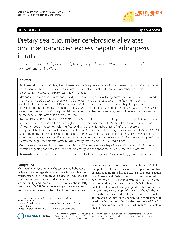摘要
Background: Nonalcoholic fatty liver disease (NAFLD) is a prevalent chronic liver disease in industrialized countries. The present study was undertaken to explore the preventive effect of dietary sea cucumber cerebroside (SCC) extracted from Acaudina molpadioides in fatty liver rats. %26lt;br%26gt;Methods: Male Wistar rats were randomly divided into four groups including normal control group, NAFLD model group, and two SCC-treated groups with SCC at 0.006% and 0.03% respectively. The fatty liver model was established by administration of 1% orotic acid (OA) to the rats. After 10d, serum and hepatic lipid levels were detected. And the serum alanine aminotransferase (ALT) and aspartate aminotransferase (AST) activities were also determined. Besides, to gain the potential mechanism, the changes of key enzymes and gene expressions related to the hepatic lipid metabolism were measured. %26lt;br%26gt;Results: Dietary SCC at the level of 0.006% and 0.03% ameliorated the hepatic lipid accumulation in fatty liver rats. SCC administration elevated the serum triglyceride (TG) level and the ALT, AST activities in OA-fed rats. The activities of hepatic lipogenic enzymes including fatty acid synthase (FAS), malic enzyme (ME) and glucose-6-phosphatedehydrogenase (G6PDH) were inhibited by SCC treatment. And the gene expressions of FAS, ME, G6PDH and sterol-regulatory element binding protein (SREBP-1c) were also reduced in rats fed SCC. However, dietary SCC didn%26apos;t affect the activity and mRNA expression of carnitine palmitoyltransferase (CPT) in liver. Besides, suppression of microsomal triglyceride transfer protein (MTP) activity was observed in SCC-feeding rats. %26lt;br%26gt;Conclusions: These results suggested that dietary SCC could attenuate hepatic steatosis due to its inhibition of hepatic lipogenic gene expression and enzyme activity and the enhancement of TG secretion from liver.
- 出版日期2012-5-8
- 单位中国海洋大学
